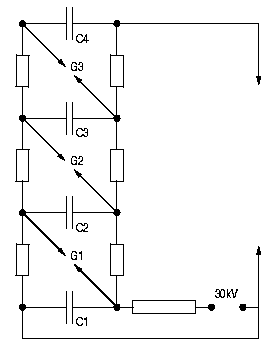

 |
 |
A Marx Generator produces a short, but very high voltage pulse by charging a stack of capacitors in parallel to a lower voltage and then switching them in series. The switching is usually done by spark gaps.
My specimen has four caps (same as I use with the tesla coil) connected by 20MOhm resistors (2x10MOhm). The three spark gaps are just bent wire. The caps are charged to nearly 30kV (TV cascade and flyback) through another 500MOhm resistor, giving a theoretical output of 120kV; the spark length is about 10cm (4"). The fact that the resulting spark length is much shorter than e.g. with the 100kV cascade has (at least) two reasons: first, pulse voltages always have shorter spark lengths than DC (the spark has not so much time to develop). Second, the caps can never be charged to full 30kV within finite time.
Note: Jim Lux says lower resistors (some kOhm) would probably improve performance, especially shorten charge-up time.